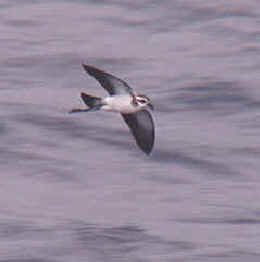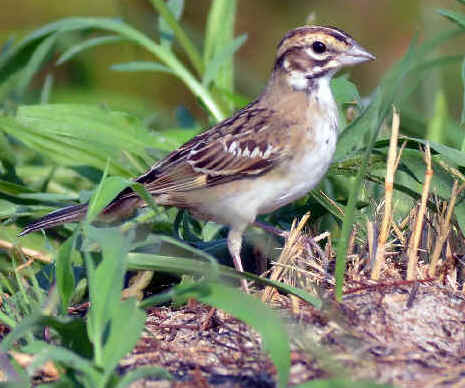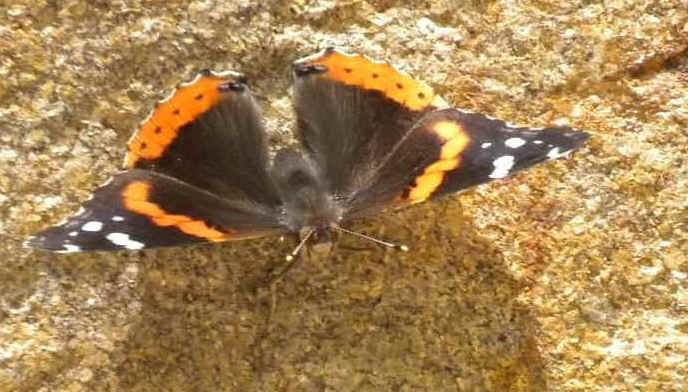The
Birdline & Natureline for August 31, 2012:
Last weekend, there were
pelagic birding trips out to sea, offshore from both
the Atlantic and Pacific coasts of the US. There were, on
both the Atlantic and the Pacific, some good finds:
Offshore from Hyannis, Cape Cod, Massachusetts, birds
included 7, yes a lucky 7 WHITE-FACED STORM-PETRELS, 9 BAND-RUMPED
STORM-PETRELS, a RED-BILLED TROPICBIRD, a BRIDLED TERN, and 3 AUDUBON'S
SHEARWATERS.
Offshore from Maryland (mostly) and Delaware,
last weekend, a TRINDADE PETREL was seen. The species has also
been called the HERALD PETREL, but that name is now generally with
the Pacific population, and TRINDADE with that of the Atlantic. The
bird, on August 25, was the first for Maryland.
Most North American sightings of the species have been off North
Carolina.
That petrel, by the way, is not from Trinidad off Venezuela, but
rather Trindade Island, much further east, off
northeastern Brazil.
Also:
Up to 5 BLACK-CAPPED PETRELS were seen offshore from Delmarva.
Previously, Maryland had 2 accepted records.
Most North American sightings of the species have been off North
Carolina.
And, yet more of note:
1 WHITE-FACED STORM-PETREL, nearly 60 LEACH'S STORM-PETRELS, and,
incredibly, about double that, just over 120 BAND-RUMPED
STORM-PETRELS.
Also incredibly, more BAND-RUMPED STORM-PETRELS were reported
than WILSON'S STORM-PETRELS. With just 85 of the latter.
Also 1 BRIDLED TERN and 1 LONG-TAILED JAEGER.
As to where some of the seabirds just mentioned come from, a quick
summary:
The BLACK-CAPPED PETREL breeds on Caribbean islands, mostly
Hispaniola, on mountaintops.
The WHITE-FACED STORM-PETREL breeds in the eastern Atlantic Ocean on
the Selvagens and Cape Verde Islands (the latter off the west coast
of Africa).
The BAND-RUMPED STORM-PETRELS of the North Atlantic are of two
types: the GRANT'S and the MADEIRAN. They nest on the Selvagens, and
the Madeiran, Canary, and Azore Islands in the eastern North
Atlantic.
On the other side of North America, offshore from Half Moon Bay, California,
last weekend:
a HAWAIIAN PETREL was among the birds seen. The first for that
county of San Mateo. That bird, by the way, was about 2,500 miles
from Hawaii, where the species nests.
Like the TRINIDADE and the BLACK-CAPPED PETRELS, the HAWAIIAN PETREL
is in the Pterodroma genus, with "Pterodroma" meaning
"winged runner". In other words, "fast-flying".
Also seen out of Half Moon Bay that day were: 2 LAYSAN ALBATROSSES,
BLACK-FOOTED ALBATROSS, SOUTH POLAR SKUA, and 4 species of
STORM-PETRELS: ASHY, BLACK, FORK-TAILED, and WILSON'S STORM-PETRELS.
There were, as there often are, hundreds of ASHY STORM-PETRELS.
But there were also, more unusually, nearly 50 WILSON'S
STORM-PETRELS. That's a high number there, as that species is
not nearly as common off the West Coast of North America as
it can be off the East Coast.
From the oceans off the coasts of North America, let's now go
inland, way inland, to Minnesota, where a most
impressive irruption of RED CROSSBILLS has been happening.
At the hawk watch, at Hawk Ridge, in Duluth, birds
other than hawks are counted.
Back on August 19, a total of 365 RED CROSSBILLS were counted as
they flew by. That was a record high daily count.
But more were to come.
On August 23, up to 603 RED CROSSBILLS,
And then, on August 24, there were 1,252 RED CROSSBILLS that
flew by Hawk Ridge, that one day! They were in 23 flocks, with an
average size of 54 birds in a flock.
The next day, August 25, there were 705 RED CROSSBILLS there.
As of August 29, as many as 3,748 RED CROSSBILLS were counted during
the month at Hawk Ridge in Duluth, Minnesota.
Actually, most have been moving just below Hawk Ridge, by the
shore of Lake Superior, rather than higher up on the ridge.
But so many - Where do they go? What do they seek?
To put in perspective, previous high daily counts in the Duluth area were,
prior to 2012:
215 on October 22, 1988,
205 on October 12, 1994,
125 on January 13, 1968,
and 106 on a Christmas Bird Count on January 1, 2006.
Never before in August have there been so many - as there have
been this month.
In eastern North America, there have some RED CROSSBILLS
noted recently in Pennsylvania and in Massachusetts
where they have been in the areas of Barre, Gill, and north
& south Quabbin.
But in the East, RED-BREASTED NUTHATCHES have begun an
irruption of their own.
With reports this month throughout Pennsylvania,
from Monroe County in the east to Cumberland, Clarion, Indiana, and
Erie Counties, further west. Also at Hawk Mountain Sanctuary, and in
southeastern Pennsylvania at the Evansburg State Park.
RED-BREASTED NUTHATCHES have appeared in northern & southern Delaware.
At Cape May, New Jersey, during a morning flight,
on August 29, as many as 374 RED-BREASTED NUTHATCHES were
tallied, among 2,700 passerines, including nearly 1,000 WARBLERS
of 24 species.
Both RED CROSSBILLS and RED-BREASTED NUTHATCHES have recently been
in Georgia, by Lake Conasauga in Murray
County.
Saranac Lake in upstate New York and the town of
Rumney (not Romney) in New Hampshire have had
something in common lately: EVENING GROSBEAKS.
Also in upstate New York:
A BROWN PELICAN was along the waterfront of Lake Erie,
in Buffalo NY on August 28.
And a FRANKLIN'S GULL was by Lake Ontario, at
Wilson, back on August 17 only.
Now, let's go back again by the 3rd of the Great Lakes
mentioned here this time, Lake Superior, and
back to Duluth:
Migrating NIGHTHAWKS have been noted, here & there, in
eastern North America, but not in numbers like this:
At Hawk Ridge, Duluth, Minnesota on August 24,
2012: 6,877 COMMON NIGHTHAWKS (yes, very common NIGHTHAWKS)
and the next day,
On August 25, 2012 at Hawk Ridge, Duluth: 3,725 COMMON (yes,
common) NIGHTHAWKS.
Not far from Duluth, in northern Wisconsin, north
of its normal range was a WHITE-TAILED KITE at the Crex Meadows
Wildlife Area in Burnett County, north of Grantsburg, on August 19.
Also in Wisconsin, north of its normal range, was a BLACK-BELLIED
WHISTLING DUCK on August 15, southwest of Madison at a place called
Shoveler's Sink.
A European (or Asian) bird
species has been at a couple places in North
America:
Single CURLEW SANDPIPERS have been in upstate New York at
the Montezuma National Wildlife Refuge on August 23, and in
northeastern Colorado at the Jackson Reservoir, in
Morgan County, from that day, August 23 until at least August 29.
Also in Colorado: a SCISSOR-TAILED FLYCATCHER has been in Jefferson
county at the Van Bibber Trail.
An American bird species has been in Europe:
An AMERICAN GOLDEN PLOVER was found in Iceland,
near Keflavik, on August 27.
The migration of HUDSONIAN GODWITS has been underway. Last weekend,
birders on a kayak on the Susquehanna River in southern Pennsylvania,
saw a flock of 15, first in flight, and then landing for a brief
time on an island, before continuing on their way.
No, sometimes they don't linger, as they have a long way to go.
About 75 per cent of all HUDSONIAN GODWITS spend our (northern)
winter in eastern Tierra del Fuego in far-southern South
America.
About 25 per cent of all HUDSONIAN GODWITS spend that season on
Chiloe Island, in south-central Chile.
A flock of 30 HUDSONIAN GODWITS was reported this past week in Delaware
at the Bombay Hook Refuge.
OSPREYS have begun their migration. To see on maps the progress of
some that have been radio-tagged in New England and
New York, you can click the link
below:
http://www.bioweb.uncc.edu/bierregaard/migration12.htm
Among the 2,700 passerine birds noted above in the Cape May,
New Jersey report, 2 were LARK SPARROWS.
Another LARK SPARROW from the western US was found yesterday, August
30, in New Jersey at the Brigantine (or Forsythe) Refuge.
Found by Harvey, and photographed by Howard, see it in the link
below:
http://www.howardsview.com/BrigAug30th_12/BrigAug30th_12.html
Now, from BIRDS to BUTTERFLIES:
Very large numbers of BUTTERFLIES have occurred this summer in southern
Canada, and further north than usual.
In July, the GIANT SWALLOWTAIL made its first appearance in Quebec.
In eastern Canada, it usually is restricted to southern
Ontario.
Also, the PAINTED LADY usually travels as far north as southern
Ontario. This summer, it has been in large numbers further north in
Quebec.
Earlier this year, the RED ADMIRAL arrived almost a month ahead
of tis normal schedule, and in larger numbers than usually seen.
On April 13, a RED ADMIRAL was observed in Quebec. Previously, the
earliest specimen there was dated May 12, 1896.
Numbers of RED ADMIRALS this year, from Windsor, Ontario
east to the province of New Brunswick are said to
be in the MILLIONS, at about 10 times what would be there during a
typical year.
Earlier here, mention was made of Hawk Ridge in Duluth,
Minnesota, and the Crex Meadows Wildlife Area
in northern Wisconsin.
A Focus On Nature tour is scheduled from October
17 to 27 to include both of those places, along with visits
in Wisconsin to the International Crane Foundation, a
renowned "Birds in Art" exhibition, and including a wild
area in northern Wisconsin, where we will meet with people from the
Timber Wolf Alliance in an area where those wild animals live.
For information about this tour, and others upcoming to places such
as Brazil, Chile, various Caribbean islands, Guatemala
and Costa Rica, please click the link below:
www.focusonnature.com
The Birdline (and the Natureline)
are affiliates of Focus On Nature Tours.
Armas Hill has presented the Birdline, originally from Philadelphia,
on the phone and internet for over 3 decades, and on the radio in
Delaware for 10 years.




